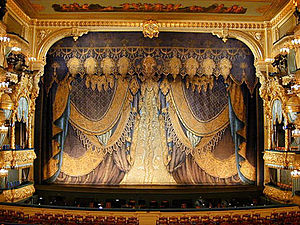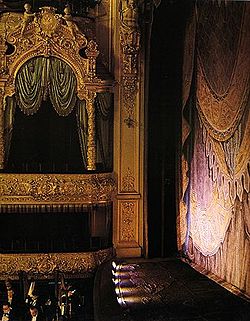- Mariinsky Theatre
-
Mariinsky Theatre 
Address 1 Theatre Square City Saint Petersburg Country Russia Architect Alberto Cavos Leased by Mariinsky Ballet
Mariinsky Opera
Mariinsky OrchestraOpened October 2, 1860 Years active 1860-present www.mariinsky.ru The Mariinsky Theatre (Russian: Мариинский театр, Mariinskiy Teatr, also spelled Maryinsky, Mariyinsky) is a historic theatre of opera and ballet in Saint Petersburg, Russia. Opened in 1860, it became the preeminent music theatre of late 19th century Russia, where many of the stage masterpieces of Tchaikovsky, Mussorgsky, and Rimsky-Korsakov received their premieres. The Mariinsky Theatre is home to the Mariinsky Ballet, Mariinsky Opera and Mariinsky Orchestra. Since Yuri Temirkanov's retirement in 1988, the conductor Valery Gergiev has served as its general director.
Contents
Name
The theatre is named after Empress Maria Alexandrovna, wife of Tsar Alexander II. There is a bust of the Empress in the main entrance foyer. The theatre's name has changed throughout its history, reflecting the political climate of the time:
From To Russian English 1860 1920 Императорский Мариинский театр Imperial Mariinsky Theatre 1920 1924 Государственный академический театр оперы и балета State Academic Theatre of Opera and Ballet 1924 1935 Ленинградский государственный академический театр оперы и балета Leningrad State Academic Theatre of Opera and Ballet 1935 1992 Государственный академический театр оперы и балета имени С.М. Кирова Kirov State Academic Theatre of Opera and Ballet 1992 Present Государственный aкадемический Мариинский театр State Academic Mariinsky Theatre Note: The acronym "GATOB" (Gosudarstvennïy Akademicheskiy Teatr Operï i Baleta) is often encountered in historical accounts.
The theatre building is commonly called the Mariinsky Theatre. The companies that operate within it have for brand recognition purposes retained the famous Kirov name, acquired during the Soviet era to commemorate the assassinated Leningrad Communist Party leader, Sergey Kirov (1886–1934).
Origins
The Imperial opera and ballet theatre in Saint Petersburg was established in 1783, at the behest of Catherine the Great, although an Italian ballet troupe had performed at the Russian court since the early 18th century. Originally, the ballet and opera performances were given in the wooden Karl Knipper Theatre on Tsaritsa Meadow, near the present-day Tripartite Bridge (also known as the Little Theatre or the Maly Theatre). The Hermitage Theatre, next door to the Winter Palace, was used to host performances for an elite audience of aristocratic guests invited by the Empress.
A permanent theatre building for the new company of opera and ballet artists was designed by Antonio Rinaldi and opened in 1783. Known as the Imperial Bolshoi Kamenny Theatre the structure was situated on Theatre Square. Both names were coined to distinguish it from the wooden Little Theatre: "Kamenny" is the Russian word for "stone" and "Bolshoi" is the Russian word for "big". In 1836, the Bolshoi Kamenny Theatre was renovated to a design by Albert Cavos (son of Catterino Cavos, an opera composer), and served as the principal theatre of the Imperial Ballet and opera.
On 29 January 1849, the Equestrian circus (Конный цирк) opened on Theatre Square. This was also the work of the architect Cavos. The building was designed to double as a theatre.[1] It was a wooden structure in the then-fashionable neo-Byzantine style. Ten years later, when this circus burnt down, Cavos rebuilt it as an opera and ballet house with the largest stage in the world. With a seating capacity of 1,625 and a U-shaped Italian-style auditorium, the theatre opened on 2 October 1860 with a performance of A Life for the Tsar. The new theatre was named Mariinsky after its imperial patroness, Empress Maria Alexandrovna.
Leading Role
The Imperial Mariinsky Theatre and its predecessor, the Bolshoi Kamenny Theatre, hosted the premieres of many of the operas of Mikhail Glinka, Modest Mussorgsky, and Pyotr Ilyich Tchaikovsky. At the behest of the theatre director Ivan Vsevolozhsky, both the Imperial Ballet and the Imperial Opera were relocated to the Mariinsky Theatre in 1886, as the Bolshoi Kamenny Theatre was considered unsafe. It was there that the renowned choreographer Marius Petipa presented many of his masterpieces, including such staples of the ballet repertory as The Sleeping Beauty in 1890, The Nutcracker in 1892, Raymonda in 1898, and the definitive revival of Swan Lake (with Lev Ivanov) in 1895.
When the theatre was designated as principal venue of the Imperial Ballet and Opera in 1886, the theatre was extensively renovated. A lavish inauguration celebration was given at the behest of Emperor Alexander III, in which the first original ballet to be produced at the Mariinsky was given—Petipa's Les Pilules magiques, to the music of Ludwig Minkus.
Other world premieres given at the house included Mussorgsky's opera Boris Godunov in 1874, Tchaikovsky's operas The Queen of Spades in 1890 and Iolanta in 1892, the revised version of Prokofiev's ballet Romeo and Juliet in 1940, and Khachaturian's ballet Spartacus in 1956. Other notable productions included Rimsky-Korsakov's opera The Golden Cockerel in 1909 and Prokofiev's ballet Cinderella in 1946 (with Natalya Dudinskaya).[1]
The imperial and Soviet theater was the home of numerous great impresarios, conductors, and musicians.
Conductors : Mikhail Zhukov (1932–1935), Israel Chudnovsky and others.
Ballet : The Vaganova Academy of Russia Ballet, the ballet school of the Mariinksy Theatre, spawned careers of Mathilde Kschessinskaya, Olga Preobrajenskaya, Anna Pavlova, Tamara Karsavina, Vaslav Nijinsky, Marina Semenova, George Balanchine, Galina Ulanova, Rudolf Nureyev, Natalia Makarova, Mikhail Baryshnikov, Irina Kolpakova, Galina Mezentseva, Altynai Asylmuratova, and in more recent times dancers of renown like Ulyana Lopatkina, Diana Vishneva, and Svetlana Zakharova.
The Mariinsky Theatre today
Under Yuri Temirkanov, Principal Conductor from 1976 to 1988, the Opera Company continued to stage innovative productions of both modern and classic Russian operas. However, since 1988, under the artistic leadership of Valery Gergiev, the Opera Company has entered a new era of artistic excellence and creativity.
Although functioning separately from the Theatre’s Ballet Company, both Opera and Ballet Companies are headed by Gergiev as Artistic Director of the entire Theatre. His tenure as head of the present day Opera Company at the Mariinsky Theatre began in 1988 and (especially since 1993) Gergiev’s impact on opera there has been enormous. Firstly, he reorganized the company’s operations and established links with many of the world's great opera houses, including the Royal Opera House, Covent Garden, the Metropolitan Opera, the Opéra Bastille, La Scala, La Fenice, the Tel Aviv Opera, the Washington National Opera and the San Francisco Opera. Today, the Opera Company regularly tours to most of these cities.
Gergiev has also been innovative as far as Russian opera is concerned: in 1989, there was an all-Mussorgsky festival featuring the composer’s entire operatic output. Similarly, many of Prokofiev’s operas were presented from the late 1990s. Operas by non-Russian composers began to be performed in their original languages, which helped the Opera Company to incorporate world trends. The annual international "Stars of the White Nights Festival" in Saint Petersburg, started by Gergiev in 1993, has also put the Mariinsky on the world’s cultural map. That year, as a salute to the imperial origins of the Mariinsky, Verdi's La forza del destino, which received its premiere in Saint Petersburg in 1863, was produced with its original sets, costumes and scenery. Since then, it has become a characteristic of the "White Nights Festival" to present the premieres from the company’s upcoming season during this magical period, when the hours of darkness practically disappear as the summer solstice approaches.
Presently, the Company lists on its roster 22 sopranos (of which Anna Netrebko may be the best known); 13 mezzo-sopranos (with Olga Borodina familiar to US and European audiences); 23 tenors; eight baritones; and 14 basses. With Gergiev in charge overall, there is a Head of Stage Administration, a Stage Director, Stage Managers and Assistants, along with 14 accompanists.
In 2003, construction began on a new home for the theatre, to be named The Second Stage. Technical difficulties connected with sub-soil problems have led to a slowing down in its progress, but work is continuing.
The Canadian firm, Diamond and Schmitt Architects, along with its local partner KB ViPS Architects have designed a building with 2,000 seats, which will complement the existing 1,600-seat Mariinsky and the nearby Mariinsky Theatre Concert Hall, which was designed by French architects Xavier Fabre and opened in spring 2007 with room for 1,100 patrons. The completion of the new Mariinsky will result in what some have called Saint Petersburg's equivalent of New York's Lincoln Center.
The Mariinsky Record Label
In 2009, the Mariinsky Theatre launched its own record label, managed by the same team that run the LSO Live label in London. All titles are recorded in the new Mariinsky concert hall in St Petersburg and released on Super Audio CD as well as on download.
Currently available titles:Rachmaninov: Piano Concerto No 3 / Rhapsody on a Theme of Paganini performed by Denis Matsuev, conducted by Valery Gergiev Mariinsky Label Website
Shchedrin: The Enchanted Wanderer conducted by Valery Gergiev Mariinsky Label Website
Shostakovich: The Nose conducted by Valery Gergiev Mariinsky Label Website
Shostakovich: Symphonies Nos 1 & 15 conducted by Valery Gergiev Mariinsky Label Website
Stravinsky: Oedipus Rex / Les Noces conducted by Valery Gergiev Mariinsky Label Website
Tchaikovsky: 1812, Moscow Cantata, Marche Slave conducted by Valery Gergiev Mariinsky Label WebsiteReferences
- Notes
- ^ Kisselgoff, Anna (1 February 2003). "Natalya Dudinskaya, 90, A Leading Kirov Ballerina". The New York Times. http://www.nytimes.com/2003/02/01/arts/natalya-dudinskaya-90-a-leading-kirov-ballerina.html?pagewanted=all.
- Sources
- Allison, John (ed.), Great Opera Houses of the World, Supplement to Opera Magazine, London, 2003.
- Beauvert, Thierry. Opera Houses of the World, The Vendome Press, New York, 1995. ISBN 0-86565-978-8
- Krasovskaya V.M. Балет Ленинграда: Академический театр оперы и балета им. С.М. Кирова. Leningrad, 1961.
External links
- Mariinsky Theatre Official Website
- Gallery of the Mariinsky Theatre
- Virtual Tour of the main hall of the Mariinsky Theatre
- Panorama of Theatre Square outside of the Mariinsky Theatre
- Perrault design of the Mariinsky Theatre that is not being built.
- The new Jack Diamond design that is being built
- Satellite image of the Theatre, centered on the main entrance
- From Toronto with love, a new theatre for St. Petersburg
- Photo: life in the Mariinsky Theatre
- Videos of Mariinsky Theatre performances
Coordinates: 59°55′32″N 30°17′46″E / 59.92556°N 30.29611°E
Mariinsky Theatre, Saint Petersburg Stock company Conductor and opera company director Valery Gergiev | 22 sopranos · Anna Netrebko | 13 mezzo-sopranos · Olga Borodina | 23 tenors | eight baritones | 14 basses
Stages Main stage · Second stage · Concert Hall · Theatre MuseumCategories:- Theatres in Saint Petersburg
- Opera houses in Russia
- Buildings and structures in Saint Petersburg
- Visitor attractions in Saint Petersburg
- Buildings and structures completed in 1860
- Russian ballet
Wikimedia Foundation. 2010.



